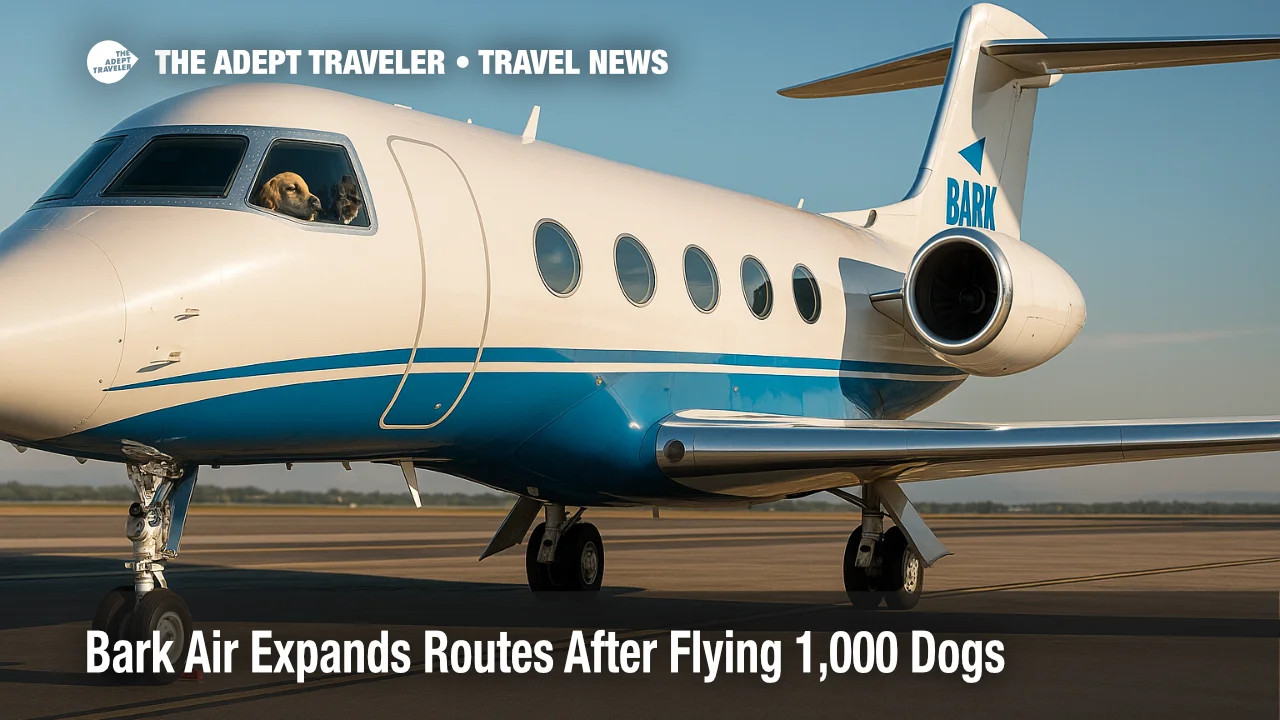Bark Air Expands Routes After Flying 1,000 Dogs

Bark Air, the dog-first charter carrier, is celebrating its first-year milestone-more than 1,000 four-legged passengers-by adding new cities on both sides of the Atlantic. The airline now links Westchester County Airport (HPN) with Van Nuys Airport (VNY), London's Biggin Hill (BQH), Paris, Lisbon, Madrid, Seattle, South Florida, and San Francisco, while opening shared and private charter bookings. Co-founder Matt Meeker says the aim remains simple: treat pups as VIPs, not cargo. Early demand suggests the strategy is working, even with fares approaching $8,900 for a New York-London seat.
Key Points
- Why it matters: Shows rising demand for premium pet-friendly air travel.
- Travel impact: New routes give U.S. and EU dog owners nonstop options every two weeks.
- What's next: Larger jets and lower fares are planned as the fleet grows.
- Optional charters let groups of dog owners split costs.
- Safety rules mirror human seat-belt use during taxi, takeoff, landing, and turbulence.
Snapshot
In just 14 months, Bark Air has operated 142 Gulfstream flights, covering nearly 400,000 miles while maintaining a 12 percent repeat-customer rate. Cabin crews greet dogs with calming aids, plush beds, and a drink of choice during ascent to ease ear pressure. Owners skip TSA lines and arrive only an hour before departure at private terminals. Fares remain steep-about $8,900 one-way on New York-London-but include one human companion, unlimited treats, and ground-side concierge service. Non-canine pets may fly, yet must stay inside carriers.
Background
Launched in May 2024 with a single New York-Los Angeles hop, Bark Air pitched itself as an antidote to pet-hold horror stories. Traditional carriers either restrict cabin pets by weight or consign them to temperature-controlled holds, a practice many owners fear. Bark Air instead charters Gulfstream G4 and G5 jets, capping loads at ten dogs per flight to ensure space for roaming. Routes quickly extended to London, and by mid-2025 the network spanned six U.S. and four European gateways. Early flights sold out despite $6,000-$9,000 price tags, proving an affluent niche willing to pay for stress-free pet travel.
Latest Developments
Charter-sharing broadens access
New software lets strangers team up on a charter, dividing the daily aircraft fee among up to ten tickets. Bark Air says the model cuts per-seat costs by roughly 25 percent, particularly on seasonal runs to Paris and Lisbon. Interested owners can join a wait-list on the Bark Air website. Slots open once enough dogs register for a given date; confirmation triggers a dedicated concierge chat. The carrier believes the scheme will draw leisure groups, breeders, and competitive-show handlers seeking flexible timetables.
Pricing, policies, and future fleet
Tickets on transatlantic sectors average $8,900, while shorter U.S. legs hover near $6,000. Flights depart roughly every other Friday, a cadence the company attributes to balancing dog demand with aircraft repositioning. Expansion plans include larger twin-jet CRJ-200s, which would double canine capacity and-if load factors hold-trim fares toward $5,000. Cats and birds remain welcome but must stay leashed inside carriers. Dogs may lounge unleashed once cruising altitude is reached, provided they return to a harness during turbulence.
Analysis
Pet ownership has surged since 2020, and with it the willingness to invest in premium travel experiences. Bark Air cleverly leverages that trend, positioning itself between commercial cabin-pet policies and full private-jet charters. By using Part 380 public-charter rules, the company avoids the capital burden of FAA Part 121 certification while still commanding elite fares. The brand synergy with BarkBox provides a ready-made customer base of affluent dog lovers. Yet growth hinges on price elasticity; mainstream travelers may balk at a ticket that rivals first-class human fares. Introducing CRJ-200s could be pivotal, offering economies of scale without sacrificing the white-paw service ethos. Competitors are scarce, though JSX and Aero have signaled interest in relaxed pet rules. Regulatory scrutiny also looms; should an incident occur, the model's reliance on third-party operators may face public-relations stress. For now, Bark Air's milestone affirms a profitable niche in experiential pet travel, but sustaining momentum will require balancing exclusivity with broader affordability.
Final Thoughts
Bark Air's first-year success underscores a shifting paradigm-pets are family, and families pay for comfort. If larger jets lower fares without diluting service, the carrier could cement itself as the default choice for long-haul canine travel. Until then, the airline remains a premium solution for those prioritizing peace of mind over price, proving that tail-wagging wanderlust can truly take flight with Bark Air.
